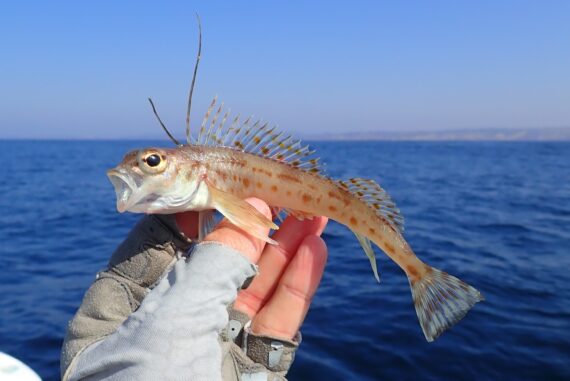Longspine Combfish, Zaniolepis latifrons
 Longspine Combfish, Zaniolepis latifrons. Fish caught from coastal waters off San Diego, California, October 2020. Length: 12.7 cm (5.0 inches). Catch courtesy of Steve Wozniak, Alamo, California. Photograph and identification courtesy of Ben Cantrell, San Diego, California.
Longspine Combfish, Zaniolepis latifrons. Fish caught from coastal waters off San Diego, California, October 2020. Length: 12.7 cm (5.0 inches). Catch courtesy of Steve Wozniak, Alamo, California. Photograph and identification courtesy of Ben Cantrell, San Diego, California.
The Longspine Combfish, Zaniolepis latifrons is a member of the Combfish or Zaniolepididae Family, and is also known as the Longspine Greenling and in Mexico as cepillo espina costa. Globally, there are three species in the family and two species of the Zaniolepis genus are found in Mexican waters of the Pacific Ocean.
The Longspine Combfish has a very slender elongated compressed body. They are tan or pink dorsally with darker diffuse markings transitioning to white ventrally. Underwater they have a series of dark saddles on the back and various blotches and spots on the side and a wide black stripe that extends from the tip of the snout to the eye and dark bands on the dorsal fin. The anal fin is long with a wide dark stripe and a white margin; their caudal fin is dark brown with a yellow line at the base and a yellow margin; their first dorsal fin is pale with three rows of dark spots, one at the base, one in the middle and one at the margin; and their pectoral and pelvic fins are similar in size and color being dark brown in the middle and yellow or white at the margins. Their head is relatively short with a sharply pointed snout having a small terminal mouth with the eye set high on the head. Their anal fin has 3 spines and 15 to 17 rays with a long base; their caudal fin is square; their first dorsal fin has 21 or 22 spines, the first three spines being very elongated and with a long base; their second dorsal fin has 11 or 12 rays; and, their pectoral fin has 14 rays. They have 11 or 12 gill rakers. They are covered with small scales and rough to the touch.
Longspine Combfish is a benthic species that is found from the intertidal zone to depths up to 420 m (1,380 feet) over mud and cobble, and pebble bottoms with larger fish found in deeper waters. They reach a maximum of 31 cm (12 inches) in length. They feed on amphipods, copepods, isopods, polychaetes, shrimps and fish eggs. In turn they are preyed upon by various sea birds, sea lions, and various fishes. Reproduction is via batch spawning with each female producing three clutches a year and as many as 6,500 eggs each year. They have life spans of 7 years. The Longspine Combfish is poorly studied with very limited information available about their lifestyle and behavioral patterns including specific details on age, growth, longevity, movement patterns, diet, habitat use, and reproduction.
In Mexican waters the Longspine Combfish is a resident of the Pacific but has a limited range being found from just north of Magdalena Bay, Baja California Sur, northward along the central and northwest coasts of Baja.
The Longspine Combfish is straightforward to identify but is similar to and can be confused with the Shortspine Combfish, Zaniolepis frenata (second dorsal spine not elongated).
From a conservation perspective the Longspine Combfish has not been formally evaluated. They are generally small and those of significant size are seldom seen by humans, are only found in deep waters and therefore of limited interest to most.